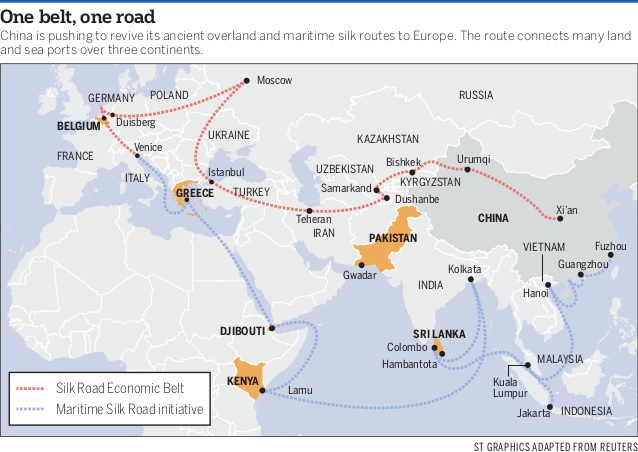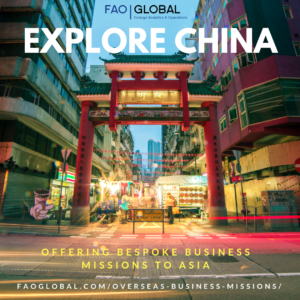By Cherie Walterman, Trade & Policy Analyst & Brandon Hughes, FAO Global Founder
Written: 6/22/2017
Background

Source: Reuters
On May 14, 2017, the People’s Republic of China’s (PRC) President Xi Jinping, unveiled China’s new global economic strategy during the Belt and Road forum in Beijing. The resulting proposal dubbed the ‘One Belt, One Road (OBOR)’ initiative may arguably be the most ambitious in terms of formalized trade expansion since the founding of the PRC. Since 1949, the Chinese government commenced several large-scale development policies with mixed results. More recent policies have turned China into a global driver of economic growth; each one a little bit more progressive than the last. President Xi originally proposed the OBOR project in an effort to expand trade between Eurasian countries and China. However, the initiative has since grown to include Pakistan, many South Asian countries, and reaffirmed many maritime and land routes. OBOR exemplifies China’s attempt to position itself as a regional leader, and to formalize large infrastructure projects such as energy and steel projects with other countries [1]. The corridors involved in the initiative include six land “belts” identified as the Central Asia and West Asia corridor, the Mongolia Russia corridor, the New Eurasian Land-Bridge, the Pakistan corridor, the Bangladesh India corridor, the Indochina corridor, and a single Maritime Silk Road which begins in Eastern China and ends in Venice [2].
Although Beijing initially launched OBOR in 2013, the Chinese government recently unveiled more details of the economic belt during the Thirteenth-Five Year Plan meetings. The aims of the initiative include developing new opportunities for China to cooperate with various countries, expanding underdeveloped parts of Western China, and increasing connectivity and development along both the “Belts” and the “Road” [3].
The Significance of the One Belt, One Road Initiative
In 2016, the PRC experienced economic stagnation despite consistent 10 percent economic growth since former Chinese premier Deng Xiaoping’s ardent reformations in the 1980s. Most recently, China is attempting to distribute economic development back to the Western and rural parts of the country instead of the coastal cities. Leadership in Beijing proposed to improve infrastructure and trade between countries in Europe, Southeast Asia, and Northeast Asia, where the majority of the world’s population currently resides. Many economists and politicians speculate that this initiative is a push for China to expand its political strength and hegemony [4]. The project already boosted trade and outbound investment in a form of physical and monetary assets throughout the globe. Some ongoing projects include ports, roads, railways, airports, power plants, oil and gas pipelines, free trade zones, and telecommunication projects. $250 billion USD has already been used to build the aforementioned projects. It is projected to mobilize up to $1 trillion in outbound financing from the Chinese government and banks [5].
All types of industries from around the globe – manufacturing, finance, high-tech, and service companies – will want to invest in the OBOR initiative. Banks will want to establish more offices around the corridors, manufacturing firms anticipate more projects around the physical “belts,” and technological firms are selling equipment for construction. Service and consulting firms are also poised to capitalize on the much-needed expertise that many of these projects require. The initiative has the potential to become one of the most successful trade and investment projects, yet there is also a chance that OBOR will fail.
One of the risks of dealing with a Chinese company is that some companies are notorious for borrowing too much money potentially harming investors and corporations, creating increased risk of default. On May 24 of this year, Moody’s Investors Services lowered China’s credit rating, downgrading from the exceptional Aa3 score to medium-grade with relatively low risk score of A1, citing the country’s corporate debt and corruption [6]. In order to finance the initiative, Chinese investors will need to establish new multi-lateral infrastructure banks and will give out more soft loans (below-market rate of interest) to investors.
In order to fully recognize the potential global impact of the OBOR initiative, it requires an understanding of the geo-political landscape each avenue of the route will cross. The trading route goes across several continents where particular countries are currently enduring territorial disputes and wars. For example, ethnic disputes in Myanmar’s Kachin State threaten to derail the Myitsone Project, a $3.6 billion dollar hydroelectric dam, which if cancelled outright, may disrupt investor confidence affecting investment into port projects on Myanmar’s coast; one of two direct routes China has to the Indian Ocean.[7] Similarly in Karachi, Pakistan the Mayor has led protests against the provincial Singh Government demanding more funds be released for needed development projects. These additional funds are needed to regain investor confidence for development projects in Karachi and the Gwadar Port, another one of the named locations in the OBOR initiative. [8]
China, like most, is a transactional country, and typically does not get involved in something unless there is a tangible return on investment. If U.S. industries invest in China through either physical or monetary means, then they will improve China’s power within the region and be responsible to follow China’s rules. If U.S. or western firms intend to capitalize on OBOR investment they must understand the codified and un-codified conditions that one may encounter when doing direct business with a Chinese partner. U.S. Foreign Corrupt Practices Act and other federal laws may prohibit cooperation with certain types of companies in certain projects. Even outside of codified laws, organizations must understand how to navigate the complex and multilayered projects that are being created with China at the helm. These include country norms, corruption, local opposition, militant threats etc. Understanding what the norms for each organization and country are is necessary to prepare both business deployment and legal teams in the event one of these situations arise as not to break any U.S. law.
FAO Global Recommendations
Investing into the OBOR can be intimidating for firms not used to working with Chinese companies. There are a variety of financial, political, and cultural considerations to take into account. Risk mitigation measures must be in place before formalizing contracts overseas. Some Chinese organizations have earned reputations for fabricating credit scores, investing in projects that waste money, and bribing government leaders. However, in order to invest and execute this grand strategy, regulations in countries along the routes must be met by Chinese organizations as well. If the world gets involved and invests, then the idea may actually become a reality. Additionally, more foreign involvement may also positively change how Chinese companies do business and work to improve the contracts process and mitigate risk.
Potential investors should have a clear understanding of the regions involved, and should identify factors that hinder or support this initiative. Identifying the key stakeholders, municipalities, and operating mechanisms that are needed can be the difference between a failed venture and a global success. FAO Global will continue to investigate the intricacies of the OBOR initiative, and will release more reports on the specific regions and industries involved.
About the Author: Cherie Walterman is a frequent contributor to FAO Global Articles and special projects. She focuses on International Trade & Policy and has worked with some of Washington, DC’s most prestigious Law Firms. She has a B.A. in International Affairs and is currently working towards a Masters of Public Policy at George Mason University.
About the Author: Brandon Hughes is a the Founder of FAO Global and a Senior Regional Analyst-Asia for Planet Risk. He has previously worked with the U.S. Army, the Carnegie-Tsinghua Center for Global Policy, and Asia Society. He is a combat veteran and has conducted research on a wide variety of regional conflicts. Brandon holds a Masters of Law in International Relations from Tsinghua University, Beijing and has extensive overseas experience focused on international security.
REFERENCES
- China-Britain Business Council, One Belt One Road: A Role for UK Companies in Developing China’s New Initiative, http://www.cbbc.org/cbbc/media/cbbc_media/One-Belt-One-Road-main-body.pdg, page 4, accessed June 5, 2017.
- The Belt and Road Initiative: Six Economic Corridors Spanning Asia, Europe and Africa, http://china-trade-research.hktdc.com/business-news/article/The-Belt-and-Road-Initiative/The-Belt-and-Road-Initiative/obor/en/1/1X000000/1X0A36B7.htm, May 16, 2017, accessed June 5, 2017.
- China-Britain Business Council,
- Nathan Hayes, London School of Economics: The Impact of China’s One Belt One Road Initiative on Developing Countries, http://blogs.lse.ac.uk/internationaldevelopment/2017/01/30/the-impact-of-chinas-one-belt-one-road-initiative-on-developing-countries/, January 30, 2017, accessed June 6, 2017.
- PricewaterhouseCoopers, China’s New Silk Road: The Long Winding Road, https://www.pwc.com/gx/en/growth-markets-center/assets/pdf/china-new-silk-route.pdf, February 2016, accessed June 13, 2017.
- Yufan Huang, New York Times: Here’s How a Chinese Tech Firm Borrowed $2.1 Billion in a Hurry, https://www.nytimes.com/2017/06/03/business/dealbook/china-finance-leeco-debt-shadow-banking.html?smid=fb-share&referer=http%3A%2F%2Fm.facebook.com&_r=0, June 3, 2017, accessed June 6, 2017.
- Joern Kristensen, The Frontier; Life after Myitsone, http://frontiermyanmar.net/en/life-after-myitsone , June 1, 2017, accessed June 17, 2017.
- The News International: Karachi mayor leads protest against ‘discrimination’, https://www.thenews.com.pk/latest/209614-Karachi-mayor-leads-protest-against-discrimination, June 9, 2017, accessed June 9, 2017.

